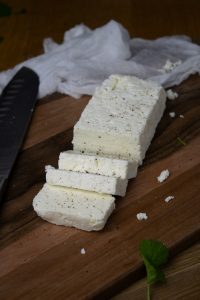
Paneer is a fresh, unsalted cheese made from cow’s milk and widely used in Indian cuisine. It’s an incredibly versatile ingredient, widely popular across the country, and has been a staple of Indian cuisine for centuries.
Paneer can be found in a variety of shapes and sizes, including cubes, slabs, and even small balls. The texture is firm and crumbly, and the flavor tends to have a mild, milky taste. This makes it an ideal choice for a variety of dishes, ranging from curries and stir-fries to salads and desserts.
Nutritional Benefits of Paneer
One of the most significant nutritional benefits of paneer is its protein content. Paneer is a good source of high-quality protein, with one serving providing around 20g of protein. Protein is an essential nutrient that plays an important role in the growth and maintenance of muscle tissue, and it’s also necessary for proper immune function.
Paneer is also a good source of calcium. Calcium is critical for bone health, and it also helps to regulate blood pressure, as well as nerve and muscle function. According to the U.S. Department of Agriculture (USDA), one serving of paneer provides around 200 mg of calcium. This is important for people who don’t get enough calcium in their diets, such as vegans and vegetarians.
Paneer is rich in phosphorous, an essential mineral that plays an important role in cell growth, energy production, and muscle and nerve function. Phosphorous is also needed for calcium absorption and helps to maintain strong bones and teeth. One serving of paneer provides around 150 mg of phosphorous.
Paneer is also a good source of B vitamins, which are essential for proper metabolism and energy production. B vitamins also help to maintain healthy skin, hair and nails, as well as cell growth and production. One serving of paneer provides significant amounts of vitamin B2, B6, and niacin.
Paneer is a good source of zinc, an essential mineral that helps to maintain a healthy immune system, as well as wound healing and the production of hormones. Zinc also helps to maintain healthy eyesight and plays an important role in reproductive health. One serving of paneer provides around 2.5 mg of zinc, which is important for those who don’t get enough in their diets.
History of Paneer
Paneer has been a part of Indian cuisine for centuries, and its origins can be traced back to the ancient Vedic period. Paneer is a type of fresh, non-melting cheese, made from curdled milk that is used in many Indian dishes. The word “paneer” comes from the Sanskrit word “paanir”, which means “cheese”.
The earliest references of paneer can be found in ancient Vedic texts. These texts describe how milk was used to create a thick and creamy substance known as curd. This curd was then pressed and shaped into blocks, with the resulting product being called “panir”. This type of cheese was likely used in making various dishes, including desserts and curries.
Paneer has also been mentioned in various medieval Indian texts, and it is believed that the Mughals had an important role in popularizing the cheese. During this period, paneer was a popular ingredient for making rich and creamy gravies and curries, and it was often used in the preparation of vegetarian dishes.
The popularity of paneer in Indian cuisine has grown over the centuries, and today, it is a staple ingredient in many dishes. Paneer is used to make a variety of dishes, from appetizers and snacks, to curries and gravies. It is also used to make desserts and sweets.
In addition to being used in Indian cuisine, paneer is also popular in Pakistani and Bangladeshi cuisine. It is often used in the preparation of dishes such as saag paneer and matar paneer, which are made with spinach or peas and cubes of paneer. Paneer is also used in Nepalese, Sri Lankan and Afghan cuisines.
Paneer is usually made from cow’s milk, but it can also be made from goat’s milk, buffalo’s milk, or sheep’s milk. The milk is curdled using lemon juice, yogurt, vinegar, or citric acid, and then pressed into blocks and cut into cubes. The cubes are then cooked in a variety of dishes.
Benefits of Cooking with Paneer
Paneer is an incredibly versatile ingredient, and it can be used in a variety of cuisines. Here are just a few of the benefits of cooking with paneer:
1. Paneer is a great source of protein. With 8 grams of protein per 100 grams of paneer, it’s an excellent way to get your daily protein requirements.
2. Paneer is a great substitute for other types of cheese, such as mozzarella or ricotta. It has a mild, milky flavor, so it won’t overpower your dish.
3. Paneer is easy to cook with. It’s a great option for those who are new to cooking since it doesn’t require any special techniques or ingredients.
4. Paneer is low in calories and fat. It’s a great choice for those who are trying to lose weight since it’s packed with protein and is low in calories.
5. Paneer is a crowd-pleaser. Since it’s relatively mild in flavor, it’s a great option for picky eaters.

How to Cook with Paneer
Paneer can be cooked in a variety of ways, and it’s an incredibly versatile ingredient. Here are a few of the most popular ways to cook with paneer:
1. Paneer can be grilled, fried, or cooked in a curry. Grilling or frying paneer is a great way to give it a crisp texture, while cooking it in a curry is a great way to give it a creamy flavor.
2. Paneer can also be used to make delicious sandwiches, wraps, and salads. It’s an excellent choice for a quick lunch or dinner.
3. Paneer can also be used to make desserts. Paneer can be combined with fruits and nuts to make delicious Indian-style desserts.
4. Paneer can be used to make cheese spreads. Simply combine paneer with spices, herbs, and other ingredients to make a delicious cheese spread.
5. Paneer can be used to make delicious snacks. Paneer nuggets, tikkas, and pakoras are just a few of the delicious snacks that can be made with paneer.
Tips for Cooking with Paneer
1. Paneer is easiest to cook when it’s fresh. Make sure to use fresh paneer for the best results.
2. If you’re using paneer to make a dish that requires frying or grilling, make sure to press down on the paneer to remove as much moisture as possible before cooking. This will help make sure that the paneer doesn’t stick to the pan or grill.
3. If you’re using paneer in a curry, you can add it towards the end of cooking so that it doesn’t become too soft.
4. Paneer can be frozen for up to three months. If you’re not planning on using it right away, it’s best to freeze it so that it doesn’t go bad.
5. Paneer can also be used raw. If you’re using it as a salad topping or in a wrap, simply slice the paneer and top off your dish.
There you have it – cooking with paneer is easy and delicious! Whether you’re looking for a vegetarian-friendly source of protein or just want to try something new, paneer is the perfect addition to your kitchen. With its mild flavor and versatility, it’s sure to become a staple ingredient in your cooking.
Clinical Trials on Paneer
A number of studies have been conducted to investigate the potential health benefits of adding paneer to the diets of people with certain medical conditions. For example, a 2013 study conducted in India investigated the effects of adding paneer as part of a weight-loss plan in individuals with obesity. The study found that adding paneer to the diet of participants resulted in improved weight loss compared to a control group. In addition, the study also found that paneer provided a source of valuable nutrients such as calcium, magnesium, and phosphorus, which helped to improve the health of participants.
Another study conducted in India in 2018 investigated the effects of paneer on patients with type 2 diabetes. The study found that adding paneer to the diets of participants significantly improved their glycemic control, as well as reducing their levels of insulin resistance. Furthermore, the study also found that adding paneer to the diet of participants also had a positive effect on their lipid profiles.